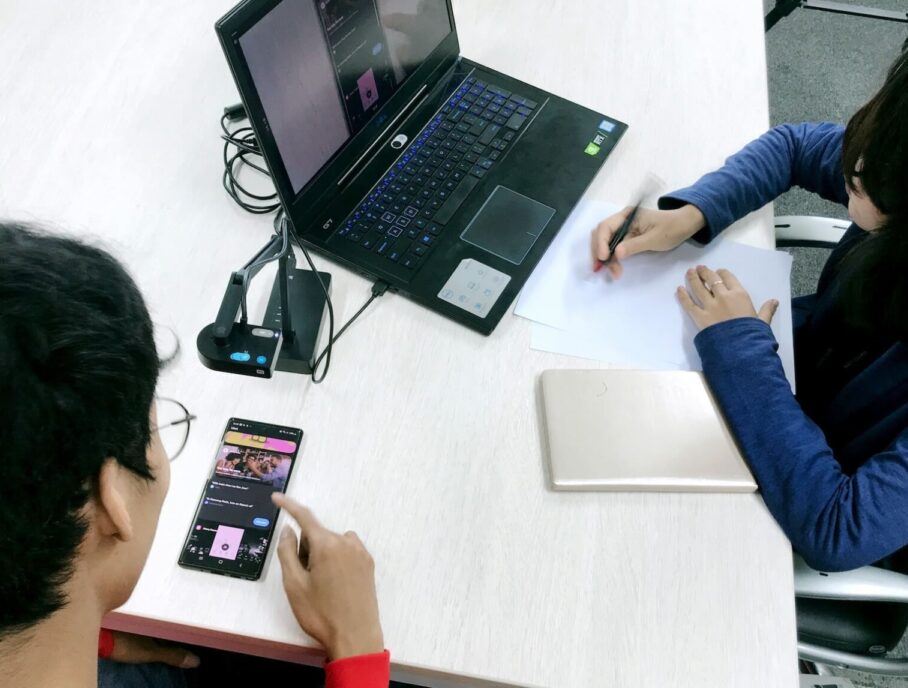
User testing is one of the most reliable ways to understand how people interact with your product and where improvements will have the greatest impact. While there are many different approaches, the key is to start with a clear research goal: what do you want to learn, and how will you use the results?
All usability tests share a few things in common:
- They use a representative set of users.
- Participants complete realistic task scenarios.
- Data is collected about what users do and say (behavioural and attitudinal).
Common testing methods
Moderated
A facilitator guides a participant, either in person or remotely (via Zoom or similar). This allows observation of how participants attempt tasks and provides the opportunity to ask follow-up questions and probe deeper.
Unmoderated remote
Participants complete tasks independently, often using platforms like UserTesting. This approach allows you to reach a larger sample, gather data quickly and reduce cost. In many cases, you receive screen and webcam recordings, but lose the ability to interact in real time.
Usability studies
One of the most important concepts in UX research is iterative testing throughout product or service development. If problems are found, it’s fine to adjust the test or design during the study and then retest to see if new problems were introduced or if the change improved the experience.
Benchmarking
Benchmark studies aim to answer: How usable is the interface? Measuring usability before design changes creates a baseline to compare against future designs. These studies usually require larger sample sizes and are often conducted using unmoderated remote methods.
Competitive testing
Benchmark data is useful, but without a comparison it can be hard to interpret. Competitive testing asks participants to complete the same tasks across your product and competitors’ products. This puts results in context and highlights areas where you lead—or lag. Because you’re comparing across products, larger samples are often required and unmoderated methods are common.
Learnability
Most usability studies measure first-time use. Learnability studies go further, tracking how quickly participants improve when attempting the same tasks repeatedly over time. These studies focus on performance data such as task time or error rate and can show where problems persist even after repeated exposure.
Think-aloud protocol
In this method, participants are asked to verbalize their thoughts while completing tasks—what they see, what they’re thinking, what they’re doing and how they’re feeling. This provides insight into cognitive processes and helps uncover pain points. Sessions are often recorded so designers and researchers can review both actions and commentary later.
Planning a usability study
Every study is different, but preparation is essential. Without it, you risk wasted sessions and shallow insights.
Define study goals
Meet with stakeholders to determine what they want to learn. Keep goals focused—too many questions dilute the quality of insights. Usability studies are best suited for behavioural questions, such as “Can people find this information?” or “Can they complete the task successfully?” If your goal is attitudinal feedback, consider other research methods.
Recruit the right participants
The best insights come from real users, or people who closely match your personas. Screen for traits, attitudes and goals that reflect your audience. Proxy users can sometimes work for general sites, but for specialized products, real users are essential.
Recruiting real users can be as easy as sending out an email with an invitation to give feedback. You can use your company's data tracking software (like Heap.io or Mixpanel.com) to find extreme or lead users. You would be surprised by how many people want to help shape the software they use.
Write realistic tasks
Tasks should match your study goals and reflect scenarios users might actually face. There are two main types:
- Exploratory tasks: open-ended and broad, used to understand discovery and navigation.
- Specific tasks: focused with clear outcomes, suited to both qualitative and quantitative testing.
- Example (exploratory): “You’re planning a family vacation. Explore the site and see if you can find an option that meets your needs.”
- Example (specific): “Find the Saturday opening hours for the Sunnyvale Public Library.”
Tasks should avoid clues that might bias behaviour. For example, if you are testing the call to action of a button, try to phrase your question about the outcome you are hoping to help users with without using the exact text on the button.
Run a pilot study
Always run a pilot to refine task wording, adjust the number of tasks per session and validate your recruiting criteria. It’s better to catch issues in advance than during live sessions.
Collect data and metrics
For quantitative studies, define metrics such as:
- Time on task
- Success rate
- Error rate
- Satisfaction ratings
Decide when to collect subjective measures (e.g., after each task or at the end of the session). In qualitative studies, metrics matter less; observations and insights take priority.
Observe sessions
Having stakeholders observe sessions builds empathy and buy-in. Seeing users struggle—or succeed—first-hand often reduces debate and accelerates decision-making. This doesn’t mean that stakeholders must be present during testing sessions, simply sharing clips of real users interacting with friction points will also accomplish building empathy.
Moderated testing checklist
Plan
- Choose a tool (e.g., Zoom) to run and record your sessions.
- Select your target audience and gather contact information.
- Decide if you will provide gratuities (e.g. gift cards).
- Book time windows 1–2 weeks in advance.
- Send invitations to participants.
- Plan how you’ll administer tasks.
- Run a pilot session internally.
- Ensure the test area can be reset between sessions.
Day of test
- Send reminder emails with connection details.
- Test your equipment.
During sessions
- Invite team members to observe.
- Ask participants for permission to record.
- Confirm the screen is being shared and the recording is active.
- Deliver tasks and capture observations.
- End the session and back up recordings.
Tip: No shows and technical difficulties are to be expected, stay calm and focus on the most critical test cases if you run short on time. With experience, you will gain confidence to deal with the unexpected with ease.
Follow up
- Send thank-you notes and gratuities.
- Save recordings for the research library.
- Synthesize findings and share highlights with your team.
















